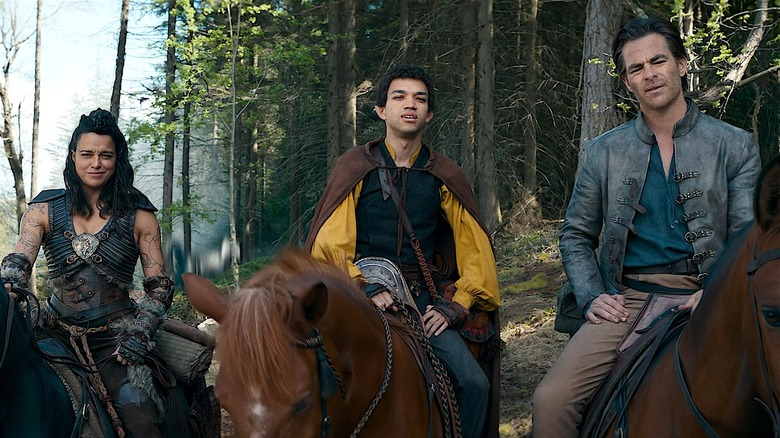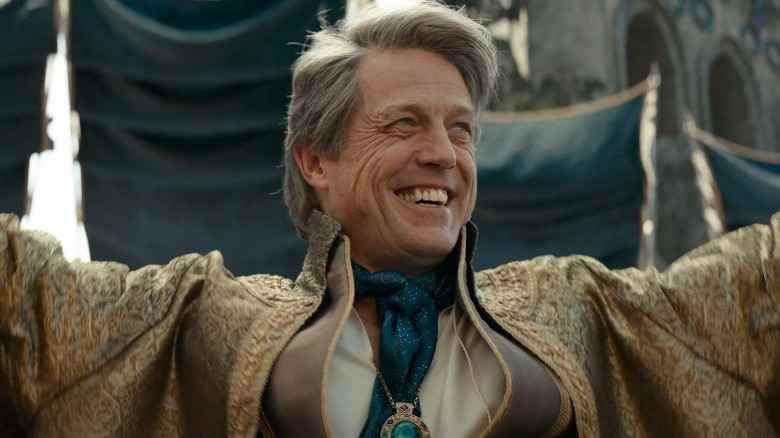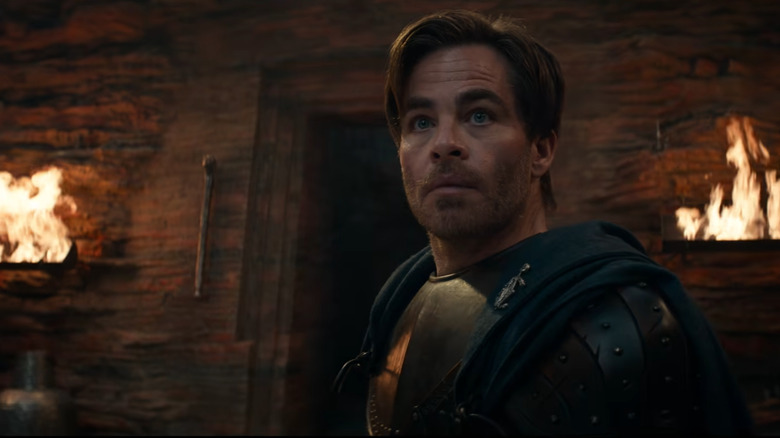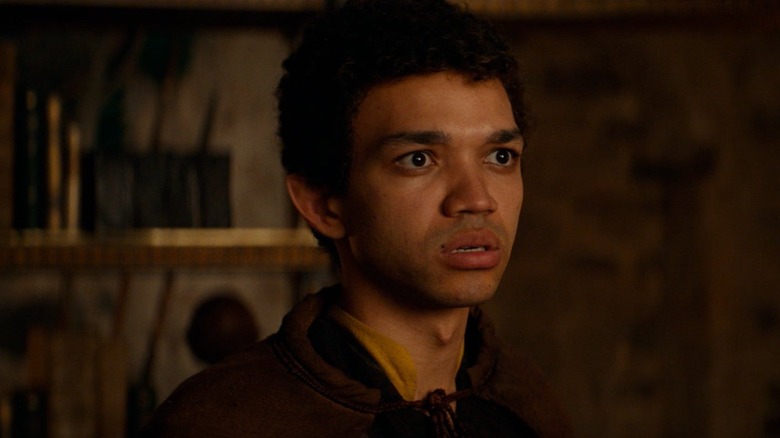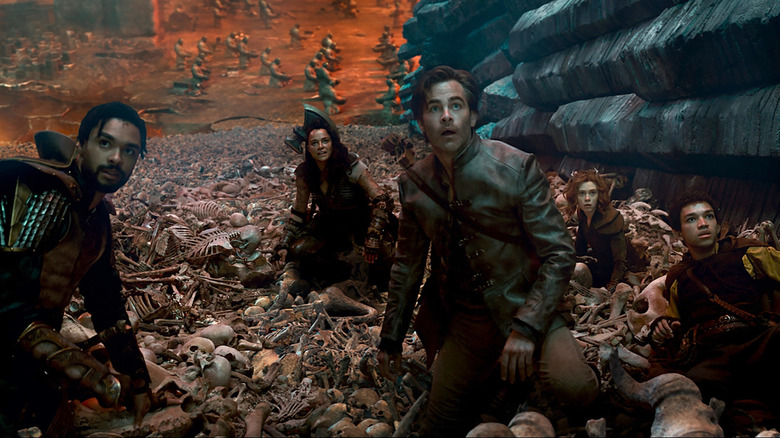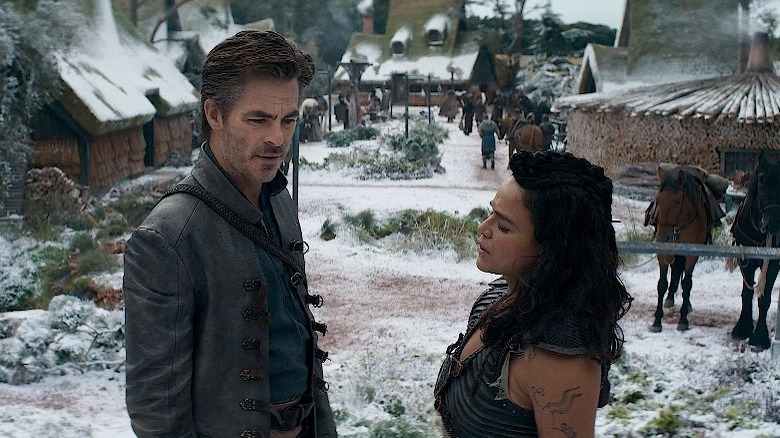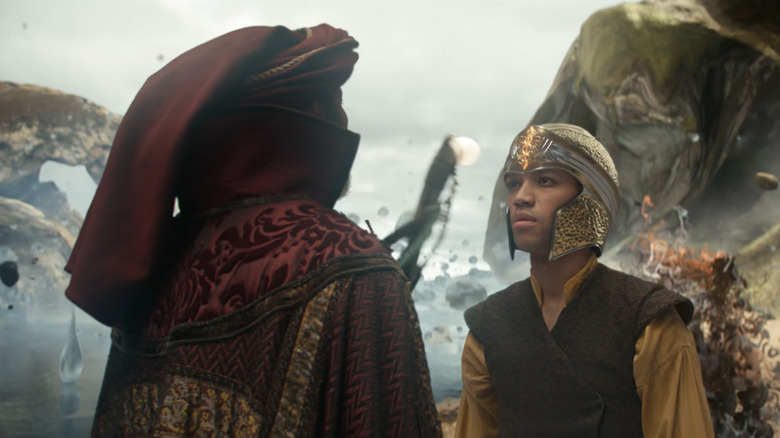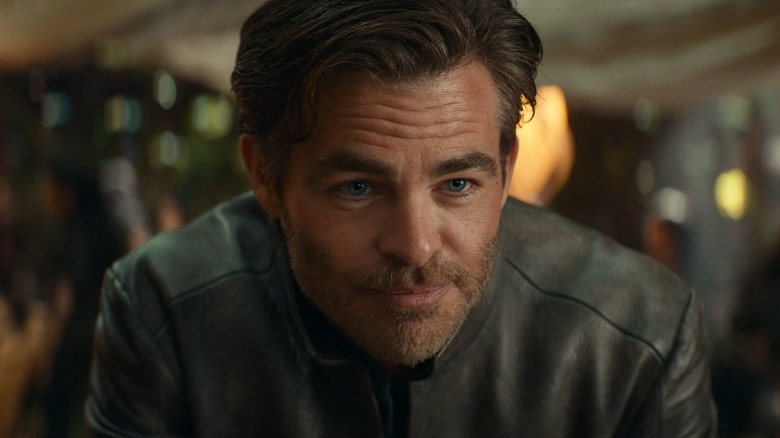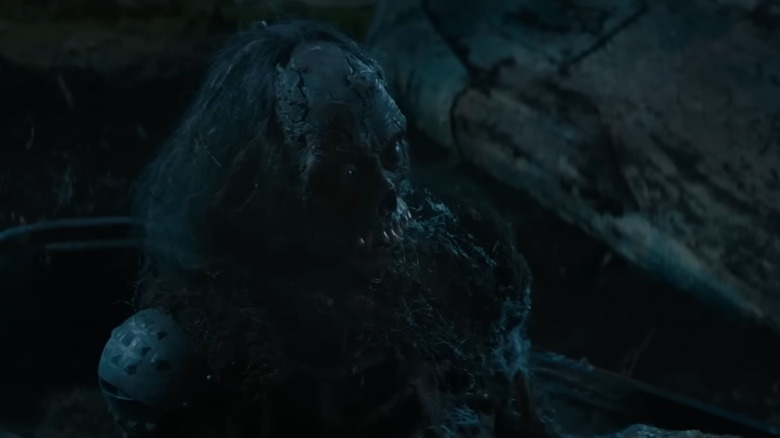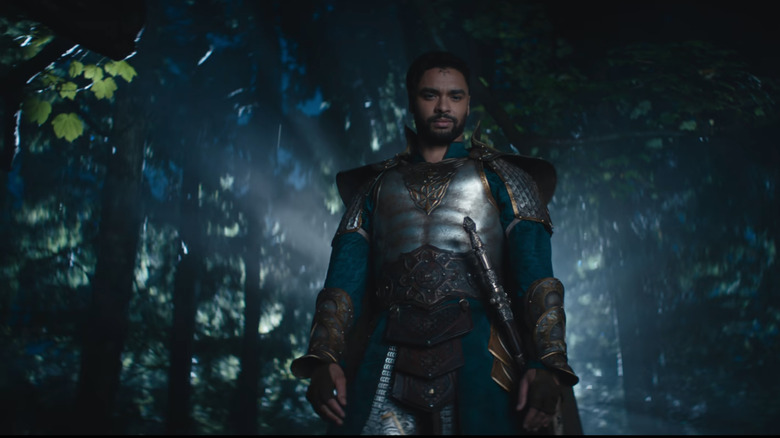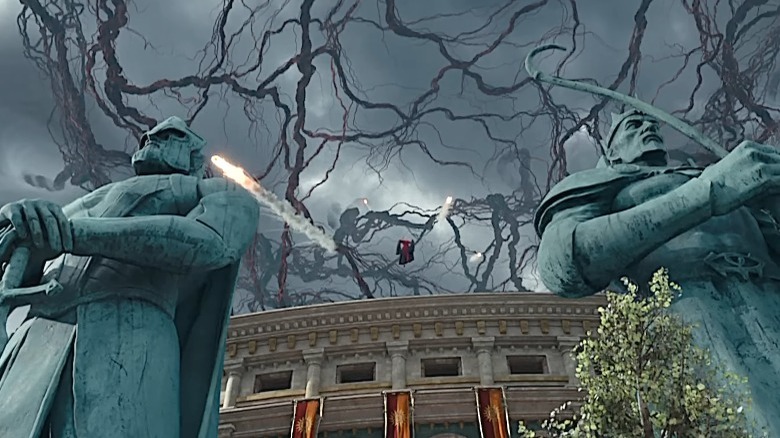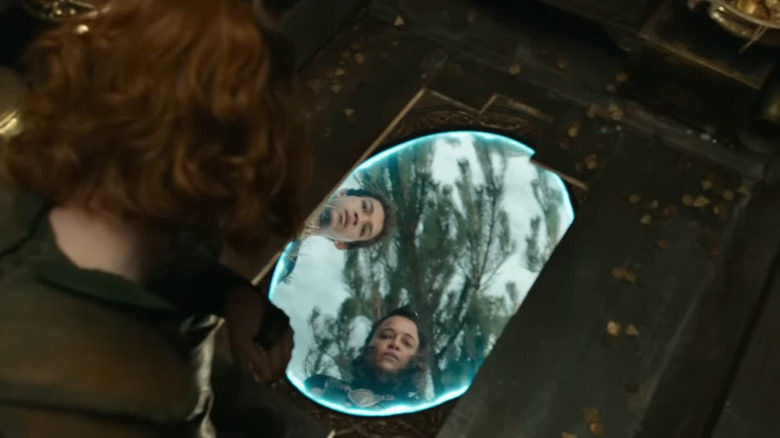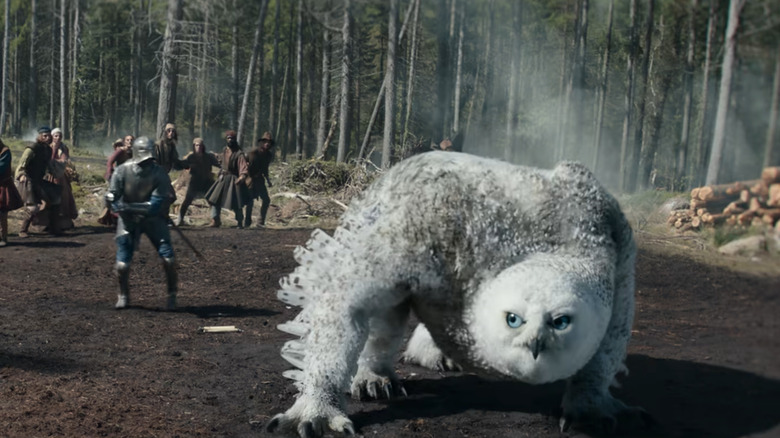The Best Uses Of Magic In Dungeons & Dragons: Honor Among Thieves, Ranked
Contains spoilers for "Dungeons & Dragons: Honor Among Thieves"
One thing that makes "Dungeons & Dragons: Honor Among Thieves" stand out from other fantasy blockbuster movies is just how much fun the filmmakers clearly had exploring creative uses of magic — a sense of fun that rubs off the viewer. It's weird to think about how few comparable fantasy blockbusters fully utilize this significant aspect of the genre, but it's been an issue for a while. Peter Jackson minimized the use of magic in his "The Lord of the Rings" films, and while the "Harry Potter" films initially included plenty of whimsical magic, by the end magic battles were reduced to characters shooting different colored beams of light out of their wands.
As such, it comes as a breath of fresh air that directors Jonathan Goldstein and John Francis Daley seem to really like magic and have a lot of clever ideas about how to visualize the game's powers onscreen. Sometimes magic is used for comedy, other times for drama, and sometimes it works on both levels. This list ranks the film's most memorable magic set pieces both by what they achieve for the film and how impactful and memorable they are.
Note that the "best" usages of magic in this context don't refer to the characters who are the best at magic – indeed, many of these scenes involve characters messing up their big magical plans in ways that are nonetheless very entertaining to watch.
12. Magic at Forge's palace
After the bard Edgin Darvis (Chris Pine) and barbarian Holga Kilgore (Michelle Rodriguez) escape from prison, they visit their former teammate Forge Fitzwilliam (Hugh Grant), who has become the Lord of Neverwinter. Forge is working alongside the Red Wizards and has his evil cohorts perform various acts of magic for him. These showcase the range of different uses for magic and the quirks of performing it.
A comedic example of this magic comes when Forge is having a hot drink and asks a Red Wizard to magically cool it down. Seems simple enough, but the execution of this spell — which involves the wizard cooling down an individual finger and sticking said finger in the drink — understandably grosses Forge out.
When Forge confirms to Edgin and Holga that he's turned on them, the magic in the scene also takes a turn in tone. The guests fall victim to a much more dangerous spell when the floor beneath them turns into quicksand, which leaves them trapped for execution. This is but a small fraction of the Red Wizards' power, but it goes to show how every aspect of the scenery in the film can be subject to magical manipulation.
11. The first Time Stop
The Time Stop spell bookends the narrative of "Dungeons & Dragons: Honor Among Thieves," as it plays an important role in the heroes' backstory while also serving as a serious threat in the final battle. As you can probably guess from the name, this spell is used to freeze time — although only within a limited range of space. Seeing the limits of the spell and the border between normal and frozen time makes for a very memorable visual effect.
The first time the Red Wizard Sofina (Daisy Head) performs Time Stop is while infiltrating a Harper stronghold with Edgin, Holga, Forge, and Simon Aumar (Justice Smith). After Sofina steals the horn she is after, Forge and Simon manage to avoid the spell and make a hasty escape. However, the Time Stop leaves Edgin and Holga frozen in place, which ultimately leads to them taking the fall for the whole party's crime and being sentenced to Revel's End prison in Icewind Dale.
10. Simon's con artistry and confusion
Simon is described in Edgin's opening narration as a "so-so sorcerer." When Edgin returns to re-recruit Simon, we get a demonstration of why this half-elf magician has both a mediocre reputation as a spellcaster and impressive hidden magical potential.
Performing on stage for the public, Simon displays a range of magic tricks that fail to impress anyone. "My five-year-old can do that," someone in the audience exclaims about Simon's Firefinger – which produces a pathetically tiny flame – and his magic simulating the smell of freshly cut grass is a comically weak excuse for a magical performance. However, while demonstrating these weak spells, Simon is secretly doing some much more skillful magic at the same time: stealing the gold out from the audience's pockets.
The execution of this con ultimately falls apart when Simon sees Edgin and Holga and gets distracted. The audience turns on him in response to discovering they've been robbed, but his response shows he's a sorcerer with immense power yet weak control over his abilities. When he intends to cast a Shield spell, he accidentally invokes a more powerful but decidedly unwanted Reverse Gravity spell! His potential is clear, even if it's going to be a tough road getting there.
9. The Firefinger becomes useful
One of the many instances of effective foreshadowing in "Dungeons & Dragons: Honor Among Thieves" sees that pathetic Flamefinger trick turn out to be a godsend when our adventurers get trapped in the Underdark. With guidance from the no-nonsense paladin Xenk Yendar (Regé-Jean Page), the party of Edgin, Holga, Simon, and Doric (Sophia Lillis) are able to find the magic-disrupting Helmet of Disjunction in the underground city. However, they also find the dragon Themberchaud ready to attack them.
The dragon corners the group at a dead end in the caves. The cave has also begun to flood, a situation that seems dire — although this eventually becomes critical to the heroes' survival. With Edgin's encouragement, Simon uses his Firefinger to amplify the dragon's gassy breath into a rock-shattering explosion in order to clear a path while the flood waters shield the adventurers from the flames. Maybe every magical five-year-old can do a Firefinger, but using it to escape the Underdark takes some serious bravery!
8. The Tablet of Reawakening
In terms of the uses of magic in "Dungeons & Dragons: Honor Among Thieves," the Tablet of Reawakening ranks relatively low on this list because it doesn't really offer any thrilling visuals or particularly creative applications. The magic is straightforward — it's a relic that allows you to resurrection someone from the dead exactly once. However, it still firmly earns a place on the list due to its narrative and emotional importance. After all, acquiring the tablet is the driving force for the entire story, and its eventual usage offers a strong payoff.
Edgin's main motivation has been seeking out the tablet to bring back his wife Zia (Georgia Landers), who was killed by a Red Wizard when their daughter Kira (Chloe Coleman) was still young. Edgin was arrested for trying to steal this tablet, and after he escapes from prison, he has to convince Kira that he committed his crimes in order to revive her mother rather than just for the riches that could come from the theft.
Thankfully, Edgin is ultimately able to retrieve the tablet and prove he wasn't lying to his daughter despite Forge's claims, which means that she'll have a chance to reunite with her mom once again. However, Kira already has a maternal figure in her life — Holga. As such, when Holga falls in the final battle, it's predictable but no less moving that Edgin ultimately decides the right way to use to tablet is to bring her back.
7. Mastering the Helmet of Disjunction
The Helmet of Disjunction is another magical object with both a straightforward in-universe purpose — it cancels out all other enchantments — and a greater symbolic meaning for the story as a whole, as learning to master it is vital to Simon's character arc. However, the helmet ranks higher than the Tablet of Reawakening due to the striking way its magic is both visualized and dramatized.
When Simon wears the helmet, the world around him becomes messy and distorted, except for the image of a figure he initially believes to be his legendary wizard ancestor Elminster Aumar. The first time Simon tries to wear the helmet, he's too overwhelmed and can't handle its power. Later on, however, he puts it on again and realizes the sorcerer he's talking to while wearing the helmet is himself.
Once he gains confidence in his powers, Simon is finally able to wield them effectively in a moment that feels victorious – even though he doesn't realize the vault he's using it to break into has already been emptied.
6. The glitching Edgin illusion
It would be a waste to make a "Dungeons & Dragons" movie where the main character is a bard and not have them do any bard activities, so of course "Dungeons & Dragons: Honor Among Thieves" has to showcase Edgin singing and playing the lute — or does it? The most notable musical performance scene in the movie is not actually played by Edgin but rather by a magical illusion of himself set up as a distraction during his party's big heist in Neverwinter.
The illusion starts off convincing, as if it could be Edgin himself singing to distract the guards, but then starts malfunctioning. First, the Edgin illusion keeps repeating the same phrase over and over again like a record skipping. Then his eyes begin to bulge and his jaw appears to melt in an image that's both hilarious and kind of creepy before the illusion ultimately disappears and we see where the real Edgin is. This visual gag is memorable enough to be recreated through paper cut-outs next to Chris Pine's name in the film's end credits.
5. Questions for the dead
One of the funniest scenes in "Dungeons & Dragons: Honor Among Thieves" showcases just how much fun and frustration can be had with the limits of magic. In contrast to the all-powerful but single-use Tablet of Reawakening, Simon's deathly token can be used to resurrect multiple corpses — but only for the sake of asking them five questions. Edgin's crew uses this ability to try and find clues to the whereabouts of the long-lost Helmet of Disjunction.
Playing out similarly to the Speak with Dead spell from the tabletop game, the adventurers have to dig up a lot of graves to make any progress. Sometimes they ask too many questions — even ones heard by but not directed at the corpses count towards the total. Other times, they get as much information as possible in just a couple of questions and have to make up irrelevant questions on the spot just to fulfill the total and give these ancient soldiers some rest.
When they finally get the information they were looking for, everyone leaves and forgets to ask the last corpse they spoke to a fifth question. Of course, this means that we see him again in the movie's mid-credits scene, where he is still waiting for that final question.
4. Fulfilling the promise to Xenk
On their quest through the Underdark, Xenk Yendar's protection of Edgin's band of thieves is contingent upon a promise that they distribute the treasures they acquire freely with the masses. When Edgin swears this oath on a Harper book, it doesn't feel as if he particularly cares for this Robin Hood-style altruism. When Sofina begins her dark magic ritual to transform the attendees of Forge's games into a zombie army, however, Edgin is inspired to come up with a magical solution that simultaneously fulfills his promise to Xenk and saves everyone from the Red Wizard's evil plot.
The magic comes from the Hither and Thither Staff, an object Holga once gifted as a walking stick to her halfling ex-husband that is actually a powerful relic able to create portals for teleportation. After Edgin's party turns Forge's stolen boat around to get closer, Simon uses the Hither and Thither Staff to teleport all the treasures carried with them on the stolen boat into the streets of Neverwinter.
With so much gold falling on the ground for the taking, everyone in the games' audience runs out of the colosseum to take for themselves, leaving Sofina without any victims to zombify.
3. The final battle
The final battle against Sofina brings many different pieces of the film's pre-established magic system together into one highly satisfying climax. Doric's shapeshifting, Sofina's Time Stop spell, Simon's disjunction magic, Kira's Pendant of Invisibility, and the anti-magic bracelets from Forge's games are all among the elements that combine into a continually exciting action sequence.
There is more of the standard shooting beams of light sort of magic battling here than in the rest of the film, but that's not as much of a problem when it's part of a more complex scene. There are also new applications of magic as we see dragon statues come to life, bubble-shaped shields for non-magic users, and even some combat between giant disembodied hands.
Kira saving the day by putting the anti-magic bracelet on Sofina is a sweet culmination of their father-and-daughter storyline, while Holga's temporary death gives the battle some needed weight. The last comedic beat of the battle, with Doric in owlbear form tossing around Sofina, is admittedly very similar to Hulk's beatdown of Loki in "The Avengers," but hey — it was awesome then, and it's still entertaining now.
2. Teleporting into the vault
Edgin's main leadership skill might be making "plans that fail," but watching how those plans build on one another toward eventual success makes for entertaining drama. One of the most ambitious of these plans involves using the Hither and Thither Staff to bypass Mordenkainen's arcane seal on Castle Never's vault. This involves breaking into one of the treasure-filled wagons traveling to the games, shooting a portal onto the underside of a painting, and then getting out of the wagon without the use of portals. It all requires some major distractions to get away with, including some comedically suggestive thrusting.
Where this plan goes awry is that the painting falls face-forward onto the ground once it's placed in the storage area. It's impossible to step through a portal that leads into solid stone, so the team switches to Plan C, which is really just Plan A of using the Helmet of Disjunction again. Shapeshifting into a worm, however, Doric is able to simultaneously pull off Plan D (which is just the portal-based Plan B again) and crawl through cracks in the ground to get through the portal. Doing both plans simultaneously proves useful because it turns out the treasures were not being stored in the locked vault after all.
1. Doric's Wild Shape ability
Yeah, Doric is awesome. The tiefling druid, raised by wood elves and suspicious of humans, doesn't have as involved of a character arc compared to her teammates, but when it comes to magical ability, she's the most consistently exciting to watch in action. Her Wild Shape ability, which allows her to transform into any animal from a tiny insect to a ferocious owlbear, is used to great effect throughout the film, with clever applications in basically every major action scene. As such, we're grouping all such uses of Wild Shape as a single entry on this list.
Even if we had to divide up every instance of shapeshifting into separate entries, however, one scene would still undoubtedly top this list — Doric's infiltration and escape from Castle Never. After entering the keep as a fly to spy on Forge and Sofina, she overhears the details of the arcane seal protecting the vault. Once Sofina detects her presence, Doric has to get creative with her powers, shifting from mouse to tielfing to hawk to cat to dog to axe beak to deer in order to make her escape out of Neverwinter without being caught.
This scene is extra impressive because it's all filmed as if it's one single continuous take, and even amidst an overall well-directed movie, this stands out as unusually great filmmaking. This scene is easily one of the best action scenes of the year so far — at least as far as those not involving John Wick.
